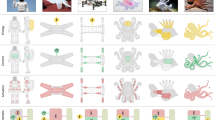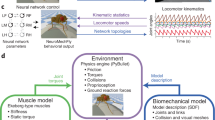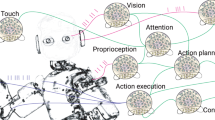Abstract
Can we now build artificial animals? A combination of robot technology and neuroethological knowledge is enabling the development of realistic physical models of biological systems. And such systems are not only of interest to engineers. By exploring identified neural control circuits in the appropriate functional and environmental context, new insights are also provided to biologists.
This is a preview of subscription content, access via your institution
Access options
Subscribe to this journal
Receive 51 print issues and online access
$199.00 per year
only $3.90 per issue
Buy this article
- Purchase on Springer Link
- Instant access to full article PDF
Prices may be subject to local taxes which are calculated during checkout



Similar content being viewed by others
References
Pichon, J.-M., Blanes, C. & Franceschini, N. in Mobile Robots IV (eds Wolfe, W. J. & Chun, W. H.) 44–53 (Society of Photo-optical Instrumentation Engineers, Bellingham, 1989).
Franceschini, N., Pichon, J. M. & Blanes, C. From insect vision to robot vision. Phil. Trans. R. Soc. Lond. B 337, 283–294 (1992).
Franceschini, N. Engineering applications of small brains. FED J. 7, 38–52 (1996).
Mura, F. & Franceschini, N. in Intelligent Vehicles II (eds Aoki, M. & Masaki, I.) 47–52 (MIT Press, Cambridge, MA, 1996).
Cruse, H., Bartling, C., Cymbalyuk, G., Dean, J. & Dreifert, M. A modular artificial neural network for controlling a six-legged walking system. Biol. Cybern. 72, 421–430 (1995).
Cruse, H., Kindermann, T., Schumm, M., Dean, J. & Schmitz, J. Walknet—a biologically inspired network to control six-legged walking. Neural Networks 11, 1435–1447 (1998).
Lambrinos, D. et al. An autonomous agent navigating with a polarized light compass. Adapt. Behav. 6, 175–206 (1997).
Lambrinos, D., Moller, R., Labhart, T., Pfeifer, R. & Wehner, R. A mobile robot employing insect strategies for navigation. Robot. Auton. Syst. 30, 39–64 (2000).
Wehner, R. in Neural Basis of Behavioural Adaptations (eds Schildberger, K. & Elsner, N.) 103–143 (Fischer, Stuttgart, 1994).
Labhart, T. Polarization-opponent interneurons in the insect visual system. Nature 331, 435–437 (1988).
Rind, F. C. & Simmons, P. J. Signalling of object approach by the DCMD neuron of the locust. J. Neurophysiol. 77, 1029–1033 (1997).
Blanchard, M., Rind, F. C. & Verschure, P. F. M. J. Collision avoidance using a model of the locust LGMD neuron. Robot. Auton. Syst. 30, 17–38 (2000).
Morse, T. M., Ferree, T. C. & Lockery, S. R. Robust spatial navigation in a robot inspired by chemotaxis in Caenorhabditis elegans. Adapt. Behav. 6, 393–410 (1998).
Damper, R. I., French, R. L. B. & Scutt, T. W. ARBIB: an autonomous robot based on inspirations from biology. Robot. Auton. Syst. 31, 247–274 (2000).
Grasso, F., Consi, T., Mountain, D. & Atema, J. in From Animals to Animats 4: Proc. Sixth Int. Conf. Simul. Adapt. Behav. (eds Maes, P., Mataric, M. J., Meyer, J. A., Pollack, J. & Wilson, S. W.) 104–112 (MIT Press, Cambridge, MA, 1996).
Grasso, F., Consi, T., Mountain, D. & Atema, J. Biomimetic robot lobster performs chemo-orientation in turbulence using a pair of spatially separated sensors: progress and challenges. Robot. Auton. Syst. 30, 115–131 (2000).
Quinn, R. D. & Ritzmann, R. E. Construction of a hexapod robot with cockroach kinematics benefits both robotics and biology. Connect. Sci. 10, 239–254 (1998).
Delcomyn, F. & Nelson, M. E. Architectures for a biomimetic hexapod robot. Robot. Auton. Syst. 30, 5–15 (2000).
Kuwana, Y., Shimoyama, I. & Miura, H. in Proc. IEEE Int. Conf. Intell. Robots Syst. 530–535 (IEEE Computer Society Press, Los Alamitos, CA, 1995).
Webb, B. What does robotics offer animal behaviour? Anim. Behav. 60, 545–558 (2000).
Webb, B. Are 'biorobots' good models of biological behaviour? Behav. Brain Sci. (in the press).
Braitenberg, V. Vehicles: Experiments in Synthetic Psychology (MIT Press, Cambridge, MA, 1984).
Huber, F. Behavior and neurobiology of acoustically oriented insects. Naturwissenschaften 79, 393–406 (1992).
Huber, F. & Thorson, J. Cricket auditory communication. Sci. Am. 253, 47–54 (1985).
Wohlers, D. W. & Huber, F. Processing of sound signals by six types of neurons in the prothoracic ganglion of the cricket Gryllus campestris L. J. Comp. Physiol. 146, 161–173 (1981).
Schildberger, K. Behavioural and neuronal methods of cricket phonotaxis. Experientia 44, 408–415 (1988).
Wendler, G. in Sensory Systems and Communication in Arthropods (eds Gribakin, F. G., Wiese, K. & Popov, A. V.) 387–394 (Birkhäuser, Basel, 1990).
Pollack, G. S. in Comparative Hearing: Insects (eds Hoy, R. R., Popper, A. N. & Fay, R. R.) 139–196 (Springer, New York, 1998).
Webb, B. in From Animals to Animats 3: Proc. Third Int. Conf. Simul. Adapt. Behav. (eds Cliff, D., Husbands, P., Meyer, J.-A. & Wilson, S. W.) 45–54 (MIT Press, Cambridge, MA, 1994).
Webb, B. Using robots to model animals: a cricket test. Robot. Auton. Syst. 16, 117–134 (1995).
Lund, H. H., Webb, B. & Hallam, J. in Fourth Eur. Conf. Artif. Life (eds Husbands, P. & Harvey, I.) 246–255 (MIT Press, Cambridge, MA, 1997).
Lund, H. H., Webb, B. & Hallam, J. Physical and temporal scaling considerations in a robot model of cricket calling song preference. Artif. Life 4, 95–107 (1998).
Webb, B. & Scutt, T. A simple latency dependent spiking neuron model of cricket phonotaxis. Biol. Cybern. 82, 247–269 (2000).
Michelsen, A., Popov, A. V. & Lewis, B. Physics of directional hearing in the cricket Gryllus bimaculatus. J. Comp. Physiol. A 175, 153–164 (1994).
Schildberger, K. Temporal selectivity of identified auditory interneurons in the cricket brain. J. Comp. Physiol. 155, 171–185 (1984).
Horridge, G. A., Loughet-Higgins, H. C. & Horridge, G. A. What can engineers learn from insect vision? Phil. Trans. R. Soc. Lond. B 337, 271–282 (1992).
Srinivasan, M. V. & Venkatesh, S. From Living Eyes to Seeing Machines (Oxford Univ. Press, Oxford, 1997).
Lewis, A. in Advances in Neural Information Processing Systems 10 (eds Jordan, M. I., Kearns, M. J. & Solla, S. A.) 822–828 (MIT Press, Cambridge, MA 1998).
Franceschini, N. & Chagneux, R. in Neurobiology: From Membrane to Mind. Proc. 25th Gottingen Neurobiol. Conf. (eds Elsner, N. & Wassle, H.) (G. Thieme, Stuttgart, 1997).
Hoshino, K., Mura, F. & Shimoyama, I. Design and performance of a micro-sized biomorphic compound eye with a scanning retina. J. Microelectromech. Syst. 9, 32–37 (2000).
Harrison, R. R. & Koch, C. A silicon implementation of the fly's optomotor control system. Neural Comput. 12, 2291–2304 (2000).
Harrison, R. R. & Koch, C. in Advances in Neural Information Processing Systems 10 (eds Jordan, M. I., Kearns, M. J. & Solla, S. A.) 880–886 (MIT Press, Cambridge, MA, 1998).
Mead, C. Analog VLSI and Neural Systems (Addison-Wesley, Reading, MA, 1989).
Hassenstein, B. & Reichardt, W. Systemtheoretische Analyse der Zeit-, Reihenfolgen-, und Vorzeichenauswertung bei der Bewungsperzeption des Rüsselkäfers. Chlorophanus. Z. Naturforsch. 11b, 513–524 (1956).
Harrison, R. R. & Koch, C. A robust analog VLSI motion sensor based on the visual system of the fly. Auton. Robot. 7, 211–224 (1999).
Weber, T., Thorson, J. & Huber, F. Auditory behaviour of the cricket I. Dynamics of compensated walking and discrimination paradigms on the Kramer treadmill. J. Comp. Physiol. A 141, 215–232 (1981).
Böhm, H., Schildberger, K. & Huber, F. Visual and acoustic course control in the cricket Gryllus bimaculatus. J. Exp. Biol. 159, 235–248 (1991).
Webb, B. & Harrison, R. R. in Proc. SPIE Symp. Sensor Fusion and Decentralized Control in Robotic Systems III (eds McKee, G. T. & Schenker, P. S.) 113–124 (SPIE, Boston, MA, 2000).
Kohstall-Schnell, D. & Gras, H. Activity of giant interneurons and other wind sensitive elements of the terminal abdominal ganglion in the walking cricket. J. Exp. Biol. 193, 157–181 (1994).
Paydar, S., Doan, C. & Jacobs, G. Neural mapping of direction and frequency in the cricket cercal system. J. Neurosci. 19, 1771–1781 (1999).
Chapman, T. Morphological and Neural Modelling of the Orthopteran Escape Response. Thesis, Univ. Stirling (2001).
Shimozawa, T. & Kanou, M. The aerodynamics and sensory physiology of range fractionation in the cercal filiform hair of the cricket Gryllus bimaculatus. J. Comp. Physiol. A 155, 495–505 (1984).
Tauber, E. & Camhi, J. The wind-evoked escape behaviour of the cricket Gryllus bimaculatus: integration of behavioral elements. J. Exp. Biol. 198, 1895–1907 (1995).
Ezrachi, E., Levi, R., Camhi, J. & Parnas, H. Right-left discrimination in a biologically oriented model of the cockroach escape system. Biol. Cybern. 81, 89–99 (1999).
Author information
Authors and Affiliations
Corresponding author
Rights and permissions
About this article
Cite this article
Webb, B. Robots in invertebrate neuroscience. Nature 417, 359–363 (2002). https://doi.org/10.1038/417359a
Issue Date:
DOI: https://doi.org/10.1038/417359a
This article is cited by
-
Enhancing optical-flow-based control by learning visual appearance cues for flying robots
Nature Machine Intelligence (2021)
-
Electric signal synchronization as a behavioural strategy to generate social attention in small groups of mormyrid weakly electric fish and a mobile fish robot
Biological Cybernetics (2021)
-
The creation of phenomena in interactive biorobotics
Biological Cybernetics (2021)
-
A dung beetle-inspired robotic model and its distributed sensor-driven control for walking and ball rolling
Artificial Life and Robotics (2018)
-
A Quadruped Robot Exhibiting Spontaneous Gait Transitions from Walking to Trotting to Galloping
Scientific Reports (2017)
Comments
By submitting a comment you agree to abide by our Terms and Community Guidelines. If you find something abusive or that does not comply with our terms or guidelines please flag it as inappropriate.



